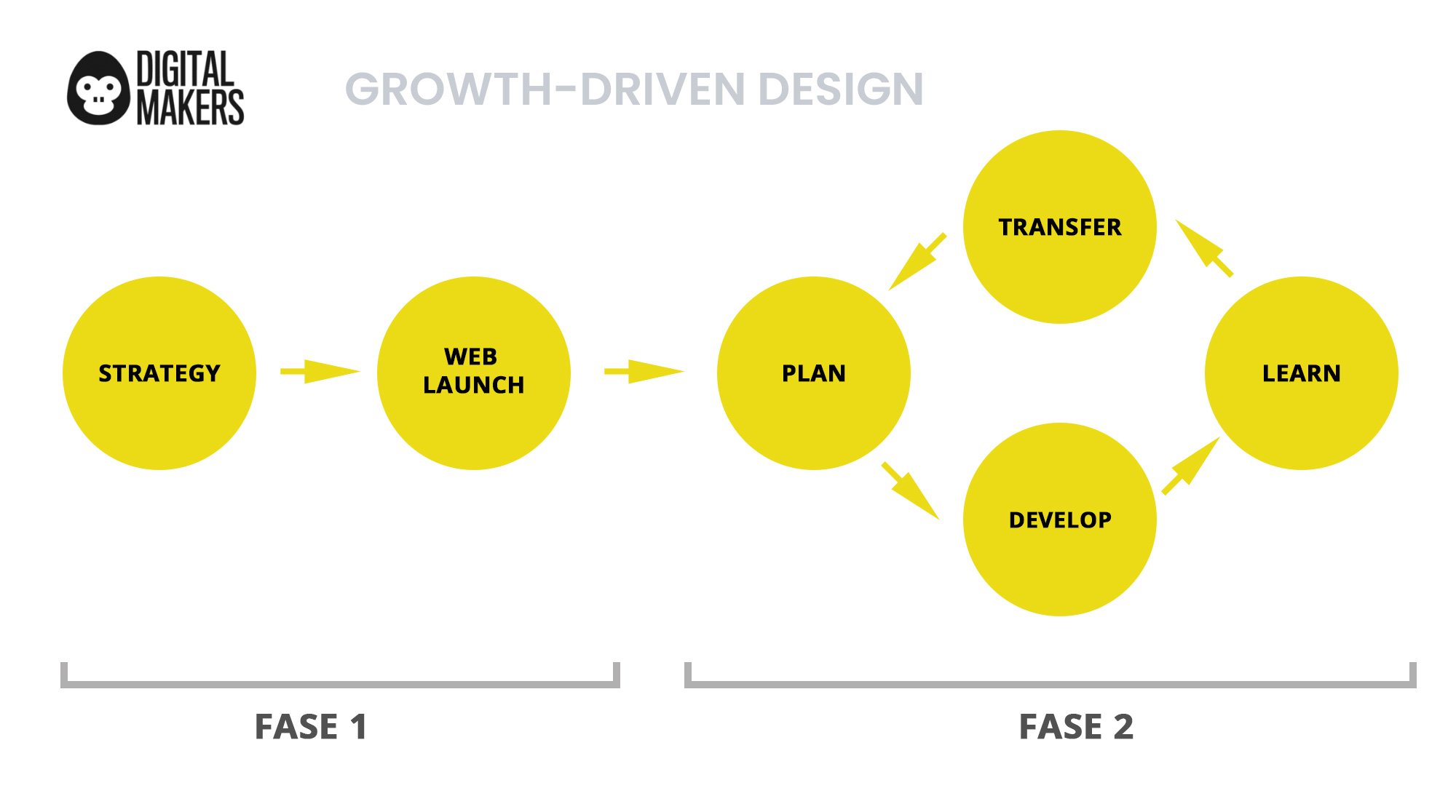In this article we will explain why the web design business trend is moving towards Growth-Driven Design and because it's worth accompanying with Hubspot.
When we talk to our customers about the latest redesign, they all remind you of the headache that involved validating each and every point on the web before going live and the delay that led to all of this. If this is your case, then surely what we will tell you now will sound.
Why is the traditional web-making system obsolete?
We see how traditional web sites were made (and made), and it starts as a turnkey project in which we have two phases:
|
Pre exit to live |
Post exit to live |
|
Phase 1 defines the aesthetics, structure and contents previously. For about 3 months the new website is prepared and published. |
In this phase, once the website has been published, the project is closed and in some cases the content and the CMS that manages it are kept to a minimum. In about 2 years the web becomes obsolete and it proposes a redesign, again entering the pre-exit phase to live. |
With this system of web creation in many cases the buyer person and the buyer journey of the users are not taken into account, but the aesthetics are prioritized over the content and usability.
Many of these websites end up as business cards where, at best, if you know the company, the products or services can be displayed as if they were a digital catalog.
Disadvantages of the traditional system
High costs up front
A traditional web for an SME can cost around 5,000 to 10,000 euros. In many cases, this cost is paid in advance and, above all, without regard to the business results.
Timings and high resources
The average time for a SME website to go live is approximately 3 months. Apart from the times, the team will have to invest a lot in facilitating and validating the entire content and the final design. All this effort, unfortunately, is not compensated until the web is public.
Hard to meet within budget and within dates
On a traditional web site, there are too many steps, people involved and processes to properly define timing and budgeting. This often results in cost overruns or extensions of terms, which gradually weaken trust with the digital provider.
Subjective design without business guarantees
Does this redesign you have envisioned for your company make your business better? Do you have a way to measure it? Once the new website has been launched in the traditional method, all you have to do is rely on the hypothesis of improvement and cross your fingers to get the results alone.
Next version? In 2 years!
The huge budget and internal team wear at the time of the redesign mean that, on average, a website will not see major changes over the next 2 years, with the exception of small news updates and certain contents. This is not the way to maximize the results of our site for business.
Seeing this ... you mean that we can use our web for more than digital catalog? What would you tell me if I told you that your website could be a 24x7 commercial? Where instead of assessing their aesthetics, you can require business goals in the same way as in your sales. If you do not believe it, then read the article because it interests you ;)

What Growth Driven Design is proposing and why your company should adopt this methodology
Today it has been proven that the main marketing asset of a company is the website, it is also the first place that our buyers visit person to look for information about our products or services.
Given this reality, the model Growth Driven Design proposes to work recurrently with iterations of improvement on our website, taking into account metrics and performing improvement actions in short cycles, favoring the conversion in each of them.
At DigitalMakers, we recommend doing this with Hubspot, as it streamlines metrics and steps to keep in mind always focusing on your business goal. It also helps to avoid wasting time by reviewing all these results by accessing different sources.
As a brief summary, we detail the method, which works on 3 basic pillars and 2 phases, let's see:
3 basic pillars of the Growth Driven Design
|
Minimize risks Learning from experience. We work to minimize the launch times of a new site, seeking maximum impact and continuous learning. |
Constant improvement It seeks to be constantly researching, testing and learning about our person buyers. Reporting on the improvements of the web in progress and using those improvements to achieve the goals. |
Measure to learn Learning about our buyer persona helps us to collaborate with marketing and sales departments and integrate strategies to impact our lead conversions. |
Once we have understood the 3 basic pillars, we will see how the strategy of the Growth Driven Design in a real project:
Phase 1: Strategy, Whislist and Launch Web
Strategy
The strategy stage is where we define the goals, the buyer persona and where we analyze the quantitative data of visits and qualitative of the contents of the previous web. In this way we will define a global strategy and by pages of the new site.
Whislist
With everything we learn in the strategy part, we are asked to do a brainstorming from where ideally 50 ideas that we believe should be applied to the new website should come from.
Launch Web
The launch version is a fast and imperfect web where the goal is to get out as soon as possible by trying to fulfill the 20% of whislist that brings the most value to the business goal. The web is not the end destination as opposed to the traditional web but the means where to start growing.
Phase 1 is ideally recommended to be completed in one month so as not to lose focus on the initially set business goal.

Phase 2: Cycle of Growth Driven Design
Plan
In line with the business goals set at the start of the project, identify whistlist items that may be most impactful at the present time and plan how to implement the first ones in the current cycle.
Develops
Implement these elements in the planning stage considering that they are an experiment, so once implemented what we want is to bring traffic in order to gather metrics that confirm if we are on the right track.
Learn
It is time to read the metrics collected on the developed experiment, we need to check if the results are closer to the goal set according to the hypothesis initially proposed.
Transfer
In order to close the circle and make iteration improvements, we will gather everything we have learned about our buyer persona and the buyer's journey to start a new cycle with improvement actions.
The second phase does not have a definite end date, although from DigitalMakers we recommend working on projects on an annual basis, thus setting a goal at the end of the year and having the time needed to achieve the goals set by our clients.
If you want to know more about how to implement the Growth Driven Design in your business, do not miss the following articles where we will detail each step of the method. In order not to miss the next articles, we recommend you subscribe to our newsletter :)











